 Now it's our time to get ready forthe fulfillment of what we come into this world for, the time of such natural changes and transformations of the body, and along with it the mind. But how often in this happy time we are filled with anxiety and along with many pleasant sensations we experience physical discomfort. The most ancient set of exercises aimed at achieving harmony and peace - yoga - helps in the best way to cope with unpleasant sensations, fears, painful conditions and will allow you to optimally prepare for the most important test - the birth of a new life. Today we will talk specifically about yoga classes for pregnant women, a technique that will become indispensable along with a knowledgeable obstetrician, support of loved ones and faith that everything will be wonderful.
Now it's our time to get ready forthe fulfillment of what we come into this world for, the time of such natural changes and transformations of the body, and along with it the mind. But how often in this happy time we are filled with anxiety and along with many pleasant sensations we experience physical discomfort. The most ancient set of exercises aimed at achieving harmony and peace - yoga - helps in the best way to cope with unpleasant sensations, fears, painful conditions and will allow you to optimally prepare for the most important test - the birth of a new life. Today we will talk specifically about yoga classes for pregnant women, a technique that will become indispensable along with a knowledgeable obstetrician, support of loved ones and faith that everything will be wonderful.
Yoga for expectant mothers - get good
First, I would like to talk about the main onestheoretical recommendations dictated by the traditions of yoga for expectant mothers, unique pillars that support the culture and are best able to help us maintain a positive attitude and good physical well-being throughout the day. These tips will help us receive prana (the life force that ensures our existence and that of our baby) in the required quantity:
- The clothes chosen by us must be made ofnatural materials: cotton, linen, wool or silk fabrics that will allow our skin to breathe deeply, will be extremely favorable to our health, and improve the aura, especially when it comes to clothes of light colors. In order not to feel constraints in movement and breathing, while taking some yoga postures for pregnant women, we will focus on free-cut clothing.
- Singing is probably the most elementary of practices.as well as expanding our lungs, helping them to open and perfectly developing the diaphragm, which will help in childbirth. Singing out of yoga class for pregnant women is very beneficial for the work of the thyroid gland and the opening of the heart center. And this is not to mention the fact that when we sing a glorious song or even a mantra during pregnancy, and after we sing it to the baby after his birth, he again plunges into pacification and a state of highest comfort, regardless of our vocal abilities.
- Start during pregnancy to engagenot every sport comes to mind, but swimming or other, more or less dynamic stays in the water, extremely relaxing effect on our entire body. Exhaust yourself with physical exertion is not worth it, but the feeling of freedom, when your whole body is supported by water, to experience during pregnancy is sacred. At this point, one can not fail to mention such a component of yoga exercises for pregnant women at home as regular taking a relaxing bath with the addition of various herbal decoctions and showers with necessarily a slight contrast of temperatures to improve blood circulation. It is also good to take a bath, as they say, with a shower in hand: while we are lying, the water will flow smoothly from our body, taking with us all the experiences of the day.
- Throughout pregnancy foradditional massage of the digestive organs, which are subject to excessive pressure as the child grows, we need walks. Walking is also good for improving the mobility of the lumbar and strengthening the abdominal muscles, which is very useful when yoga becomes an integral part of our schedule.
- Yoga for pregnant women 2 trimester should be combinedwith regular rubbing of wheat germ oil after taking a bath in the chest, thighs and tummy, and completing the procedure necessary to prevent stretch marks will be a slight pinching of the skin with your fingers, so that the oil is absorbed deeper. Almond nut oil will be similarly rubbed twice a day: before taking a bath and before going to bed. Vitamins will help the skin to be enriched with oxygen, not to mention the additional moisture that is simply necessary now when it is stretched.
- Yoga for pregnant 3 trimester will be with uscombined with frequent tingling, stretching and pulling nipples during the day, and after taking a bath you will need to rub them with a towel, all this is simply necessary to strengthen them. Periodically, we can also wash the nipples with lemon juice. It would be nice to take care of a place where you can take sun and air baths without embarrassment and interference, then we can generally call ourselves happy moms, as similar breast care is needed to reduce later discomfort during breastfeeding.
Yoga for pregnant women: home and walls help
During the existence of the doctrine, this has happened more than onceIt has been proven that a woman can help herself learn to control the course of the labor process. Subsequently, we will be able to reduce the pain of contractions to quite bearable limits with the help of breathing according to the system and taking the necessary yoga poses for pregnant women, the corresponding exercises will help speed up the process. Not to mention that some inverted asanas (body positions in which it is most pleasant and comfortable to be) will help our little one take the correct position in the tummy, and we will even control and “feel” the muscles of the uterus, and, directing the vector of efforts downwards, push correctly. Yoga can be practiced by us throughout all nine months, subject to the above rules, and if we did not practice before pregnancy, the first trimester is just perfect for starting yoga for pregnant women. Unfortunately, today we do not have the opportunity to talk in more detail about yoga for pregnant women - there are too many exercises. However, I would very much like to discuss in detail the practice, which is aimed at controlling the pelvic floor muscles, which is simply necessary, given the appearance of additional loads on these muscles with the increase in the weight of the child in the mother's womb. Such exercises will allow us to make the pelvic floor muscles more elastic for future births. But our main goal here is to understand the muscles of this area and how we can tense or relax them to make it easier for the baby to pass through the birth canal. The next positive aspect of the practice is to ensure rapid muscle recovery if we continue to practice after childbirth, and classes are simply necessary - they will significantly help in treatment even if an episiotomy is performed. You should not allow the thought of how simple yoga is for pregnant women - you can do far from everything at home, and we strongly advise you to at least consult with your doctor. But here are exercises for the pelvic floor - a fairly harmless alternation of squeezing and relaxing the perineal muscles - we will practice as often as possible (at least about 100 squeezes a day). To begin with, in order to feel these muscles, you should slightly spread your legs during urination, then begin the process of emptying the bladder and stop it by squeezing the muscles. We can easily feel our muscles if we place a finger in the vagina and squeeze the perineal muscles around it. This practice is an integral part of the program "yoga for pregnant women - 3 trimester", when the frequency of visits to the toilet will increase significantly. If we have such a conversation, then we would like to tell you in more detail about the restrictions that exist, the features that should definitely be taken into account, and the main poses that will be useful to us:
- Each Pregnancy Yoga Class - 1 Trimestershould already be marked by them - it is worth starting with breathing exercises. Pranayama (breathing practices) is simply necessary for the optimal preparation of our body for childbirth: correct breathing from the point of view of doctors and nature for three to five, or even more hours of the birth process, is very difficult to imagine without persistent training before childbirth.
 Pranayama
Pranayama
- Pay attention to the practice of the mula bandha - she is perfectly capable of preparing the crotch for the moment of the birth of the child.
- A group of asanas to strengthen the muscles of the back yoga forpregnant women - photos illustrate this - it highlights especially. Different variations of the cat, the bridge, the posture near the wall number 9, the half bridge, the posture near the wall number 10 and the options for resting the arms, in addition to preparing the spine for the last trimester of pregnancy and childbirth, are aimed at increasing the concentration and improving the work of the vestibular apparatus.
 Cat
Cat
- In case of increased fatigue and physicaltension in the last stages of pregnancy, and just to get additional pleasure from passive exercises with the hyperactive participation of daddy, yoga for pregnant women is suitable - exercises with a partner. Let him support us, helping us stand on our hands or take other asanas.
 Partner exercise
Partner exercise
- More Beneficial Yoga for Pregnancy - 2trimester, and the exercises bow on the side, half moon, cervical-thoracic bend, cat, twist No. 1, poses against the wall No. 4, 5, 6 are able to relax, relieve tension, back pain, improve blood circulation in the abdominal cavity and spine. Experts call this group "Bends and twists".
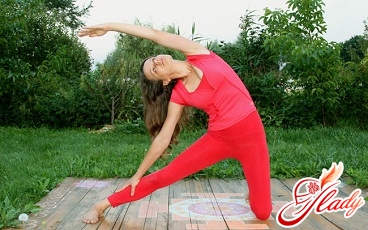 Deflections and twists
Deflections and twists
- No matter how difficult yoga is for pregnant women, the posesgroups of inverted asanas (half bridge or Depada Pidam, Viparita Korani, Handstand and Forearm Stand, Halasana, Sarvangasana, Sirsasana, Simple Bridge or Chakrasana and Birch) should attract your attention. They will help our little one to settle in the tummy according to the natural scenario of nature, will not allow us to develop varicose veins, constipation and leg cramps.
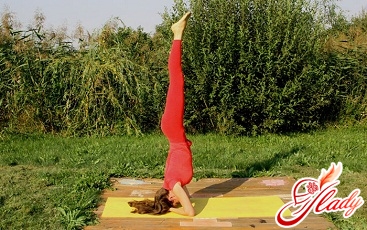 Inverted asanas
Inverted asanas
- Our priority will be yoga asanas forpregnant women - the photos provided to our attention demonstrate them - a group that promotes better "opening" of the hip joints, poses that improve blood circulation in the abdominal organs, strengthening the pelvic organs. The pose with the leg abducted to the side, pose against the wall No. 1, squatting and pose against the wall No. 15 will significantly help us at the very beginning of labor to speed up and facilitate the process of birth of the baby.
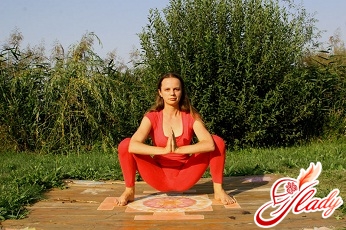 Pose for opening hip joints
Pose for opening hip joints
- Yoga for expectant mothers should rule outin which significant abdominal strain may occur. Instead, we concentrate on shavasana, padmasana, virasane, natavirasane, ardhapadmavirasana, contrast exercises and visualization - they will help us master the skill of quality relaxation.
We will end each lesson with asanas forneck and arm joints — exercises that are designed to relieve fatigue from the joints and muscles of the cervical spine: twisting and stretching the neck, rotating the neck, pose against the wall No. 19, stretching the lateral surfaces of the neck, cat, cervical-thoracic arch, rolling over the forehead, warming up the hands, rack, hand lock. All these asanas and yoga exercises for pregnant women — poses that gently strengthen all parts of the spine, develop the joints, can further help us avoid injury during childbirth (especially if we are talking about perineal injuries, which can be prevented by regular stretching exercises). According to the teachings of Patanjali — the founder of yoga and the author of the "Yoga Sutras" — and according to numerous statements by women who began to practice yoga, this practice can improve the functioning of the endocrine system, which is especially important for the harmonious course of pregnancy, and also makes the course of the birth process more favorable. Not to mention that with regular practice - yoga for pregnant women does not tolerate shirking - the rejuvenating effect of the woman's body becomes clearly noticeable.
Yoga for pregnant women - breathing exercises
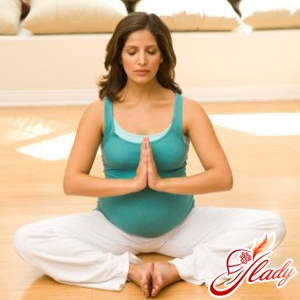 Most of the yogic breathing practices are relatedwith achieving more conscious control over your breathing. Breathing exercises can saturate the blood with oxygen, purifying it, which results in the release of toxins - the blood is renewed much faster and "better". Deep breathing according to the yogic system gives clarity to the mind, cleanses the lungs, has a calming effect on the human nervous system, activates its energy flows, helps the harmonious development of the body, improves its aura, and reduces pain. Synchronization of breathing is simply necessary for us during pregnancy, because by the third trimester, many expectant mothers have a decrease in hemoglobin levels and the "delivery" of oxygen in full is already difficult. This is aggravated by the growth of our baby and, accordingly, the tummy, which begins to "prop up" the lungs a little, not to mention vegetative-vascular dystonia, which is quite common in young women. Attacks of "suffocation" are often followed by anxiety about the health of the baby, who invariably suffers from such a state of the mother, fear for the fullness of its development in such conditions and a whole bunch of gray thoughts. Yoga for pregnant women - the first trimester - must certainly contain pranayama practices (breathing according to the yogic system) to eliminate such unpleasant moments from our "pregnant" life. The exercises given, among other things, will allow blood pressure to normalize, improve digestion, help you sleep better and do without the use of painkillers and stimulants during childbirth:
Most of the yogic breathing practices are relatedwith achieving more conscious control over your breathing. Breathing exercises can saturate the blood with oxygen, purifying it, which results in the release of toxins - the blood is renewed much faster and "better". Deep breathing according to the yogic system gives clarity to the mind, cleanses the lungs, has a calming effect on the human nervous system, activates its energy flows, helps the harmonious development of the body, improves its aura, and reduces pain. Synchronization of breathing is simply necessary for us during pregnancy, because by the third trimester, many expectant mothers have a decrease in hemoglobin levels and the "delivery" of oxygen in full is already difficult. This is aggravated by the growth of our baby and, accordingly, the tummy, which begins to "prop up" the lungs a little, not to mention vegetative-vascular dystonia, which is quite common in young women. Attacks of "suffocation" are often followed by anxiety about the health of the baby, who invariably suffers from such a state of the mother, fear for the fullness of its development in such conditions and a whole bunch of gray thoughts. Yoga for pregnant women - the first trimester - must certainly contain pranayama practices (breathing according to the yogic system) to eliminate such unpleasant moments from our "pregnant" life. The exercises given, among other things, will allow blood pressure to normalize, improve digestion, help you sleep better and do without the use of painkillers and stimulants during childbirth:
Full yoga breathing. It is necessary to sit "in Turkish" or in the position of "legs for yourself", settle down comfortably, straighten the spine (for long periods you can support your back with a small pillow), close your eyes and try to positively tune and think about something pleasant. Try to probe your body: if there are especially tense places, especially focus on their relaxation, try to “breathe” them, imagining how with each exhalation all the accumulated weight is showered from them with golden grains. Inability to fully relax as the classes will pass and after a couple of weeks you will be able to do it with ease. So, we are as close as possible to complete relaxation and proceed to the exercise itself. We inhale through the nose and fill the abdomen with air as best as possible and then the chest. Now exhale, slightly pulling in the abdomen, and then let the air out of the chest. Consider to yourself: the best option is to breath on the “four” account, and exhale on the “eight”, perhaps for the first time you will not be too successful, but with time the ideal ratio of “4/8” you will achieve. Respiratory yoga for pregnant women - 1 trimester will begin with ten exhalations and inhalations, but, guided by our feelings, we will subsequently increase the number.
Ujayi Prepare and relax, as in the first lesson. Now you need to grope, find the glottis (try a little to moan with your mouth closed). As in the exercise “full yogic breathing”, we will inhale-exhale according to the “belly-chest” system, only now, if possible, straining the glottis and controlling the air flow. Must be hiss. Starting from 3-5 minutes, in the future we will increase the duration of such yoga exercises for pregnant women to 15 minutes.
Nadishodhana. Preparation and breathing system "belly - chest", as in previous exercises. With the thumb of the right hand, it is necessary to close the right nostril, inhale with the left, after already with the index finger of the right hand, we close the left nostril and hold the breath a little. Next, open, pushing the thumb, right nostril, leaving the left closed, and deeply exhale. Now take a breath through the right. Then again cover it with your thumb, hold your breath and exhale through the left. The right nostril, as we remember, is closed. Such a systemic alternation must be repeated 5-10 times, the ideal option here is inhale to the “4” count, after a delay to the “16” count and exhale to “8.”
When doing these breathing exercisesYou should also follow some rules: Pranayama is always performed on an empty stomach, at least three hours after your last meal, early morning and before bedtime are ideal. Classes should be held in a well-ventilated room, and doing the exercises outdoors will increase their effectiveness even more. You should skip classes only if you feel really bad, but, if possible, you should still do at least one cycle of each exercise. Normally, classes should last 15-20 minutes and, if desired, be divided into two or three approaches. Exercises should be done in a quiet, calm place to be able to concentrate as much as possible on your feelings, without being distracted, bringing you closer to a feeling of deep lightness, incredible peace and tranquility. At the end of the class, if instead of positive feelings we experience dizziness, heaviness in the chest, shortness of breath, you need to reduce the duration, perhaps take a break from classes for a day or even two. Finally, I would like to mention that it is in the state of peace that yoga classes provide that it will be easiest to learn to communicate with our little one, to feel him, to begin to understand him as best as possible, which will help us and him to be even happier. We recommend reading:
Comments
comments
 Photo: GettyImages
Photo: GettyImages Our consultant is Margarita Shumilova, doctor,Candidate of Medical Sciences. Teaches hatha yoga, yoga for the health of the spine and joints, breathing practices, instructor in yoga for pregnant women. Uses yoga in the rehabilitation of various diseases.
Our consultant is Margarita Shumilova, doctor,Candidate of Medical Sciences. Teaches hatha yoga, yoga for the health of the spine and joints, breathing practices, instructor in yoga for pregnant women. Uses yoga in the rehabilitation of various diseases.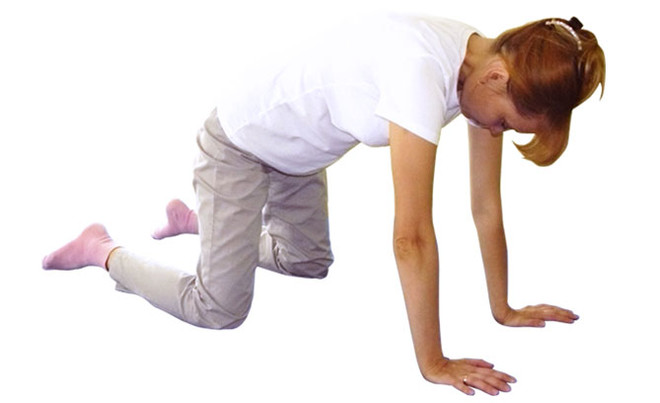 Model Svetlana, II trimester of pregnancyPhoto: Lyudmila Alekseeva Effect: improves the flexibility of the shoulder girdle, the spine, gently strengthens the upper arms, tones the reproductive organs. Technique: stand on all fours, on a slow exhale, round the spine, lowering the head and directing the chin to the chest. At the same time tighten the buttocks and move the hips forward. Rest your palms on the floor, stretch the area between the shoulder blades up towards the ceiling, stretching the muscles between the shoulder blades. On a slow inhale, straighten the spine so that the top of the head and tailbone line up (do not bend the spine to the floor). Repeat 5 times.
Model Svetlana, II trimester of pregnancyPhoto: Lyudmila Alekseeva Effect: improves the flexibility of the shoulder girdle, the spine, gently strengthens the upper arms, tones the reproductive organs. Technique: stand on all fours, on a slow exhale, round the spine, lowering the head and directing the chin to the chest. At the same time tighten the buttocks and move the hips forward. Rest your palms on the floor, stretch the area between the shoulder blades up towards the ceiling, stretching the muscles between the shoulder blades. On a slow inhale, straighten the spine so that the top of the head and tailbone line up (do not bend the spine to the floor). Repeat 5 times. Advice: use the natural increase of flexibility during pregnancy and feel how with each lesson you become more graceful.
Advice: use the natural increase of flexibility during pregnancy and feel how with each lesson you become more graceful.





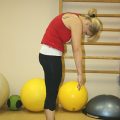



 Now it's our time to get ready forthe fulfillment of what we come into this world for, the time of such natural changes and transformations of the body, and along with it the mind. But how often in this happy time we are filled with anxiety and along with many pleasant sensations we experience physical discomfort. The most ancient set of exercises aimed at achieving harmony and peace - yoga - helps in the best way to cope with unpleasant sensations, fears, painful conditions and will allow you to optimally prepare for the most important test - the birth of a new life. Today we will talk specifically about yoga classes for pregnant women, a technique that will become indispensable along with a knowledgeable obstetrician, support of loved ones and faith that everything will be wonderful.
Now it's our time to get ready forthe fulfillment of what we come into this world for, the time of such natural changes and transformations of the body, and along with it the mind. But how often in this happy time we are filled with anxiety and along with many pleasant sensations we experience physical discomfort. The most ancient set of exercises aimed at achieving harmony and peace - yoga - helps in the best way to cope with unpleasant sensations, fears, painful conditions and will allow you to optimally prepare for the most important test - the birth of a new life. Today we will talk specifically about yoga classes for pregnant women, a technique that will become indispensable along with a knowledgeable obstetrician, support of loved ones and faith that everything will be wonderful. Pranayama
Pranayama Cat
Cat Partner exercise
Partner exercise Deflections and twists
Deflections and twists Inverted asanas
Inverted asanas Pose for opening hip joints
Pose for opening hip joints Most of the yogic breathing practices are relatedwith achieving more conscious control over your breathing. Breathing exercises can saturate the blood with oxygen, purifying it, which results in the release of toxins - the blood is renewed much faster and "better". Deep breathing according to the yogic system gives clarity to the mind, cleanses the lungs, has a calming effect on the human nervous system, activates its energy flows, helps the harmonious development of the body, improves its aura, and reduces pain. Synchronization of breathing is simply necessary for us during pregnancy, because by the third trimester, many expectant mothers have a decrease in hemoglobin levels and the "delivery" of oxygen in full is already difficult. This is aggravated by the growth of our baby and, accordingly, the tummy, which begins to "prop up" the lungs a little, not to mention vegetative-vascular dystonia, which is quite common in young women. Attacks of "suffocation" are often followed by anxiety about the health of the baby, who invariably suffers from such a state of the mother, fear for the fullness of its development in such conditions and a whole bunch of gray thoughts. Yoga for pregnant women - the first trimester - must certainly contain pranayama practices (breathing according to the yogic system) to eliminate such unpleasant moments from our "pregnant" life. The exercises given, among other things, will allow blood pressure to normalize, improve digestion, help you sleep better and do without the use of painkillers and stimulants during childbirth:
Most of the yogic breathing practices are relatedwith achieving more conscious control over your breathing. Breathing exercises can saturate the blood with oxygen, purifying it, which results in the release of toxins - the blood is renewed much faster and "better". Deep breathing according to the yogic system gives clarity to the mind, cleanses the lungs, has a calming effect on the human nervous system, activates its energy flows, helps the harmonious development of the body, improves its aura, and reduces pain. Synchronization of breathing is simply necessary for us during pregnancy, because by the third trimester, many expectant mothers have a decrease in hemoglobin levels and the "delivery" of oxygen in full is already difficult. This is aggravated by the growth of our baby and, accordingly, the tummy, which begins to "prop up" the lungs a little, not to mention vegetative-vascular dystonia, which is quite common in young women. Attacks of "suffocation" are often followed by anxiety about the health of the baby, who invariably suffers from such a state of the mother, fear for the fullness of its development in such conditions and a whole bunch of gray thoughts. Yoga for pregnant women - the first trimester - must certainly contain pranayama practices (breathing according to the yogic system) to eliminate such unpleasant moments from our "pregnant" life. The exercises given, among other things, will allow blood pressure to normalize, improve digestion, help you sleep better and do without the use of painkillers and stimulants during childbirth:




